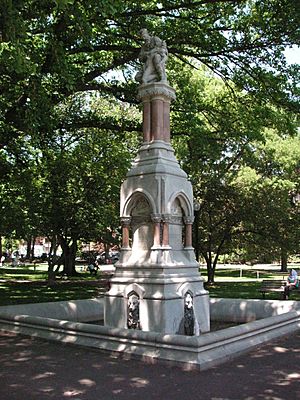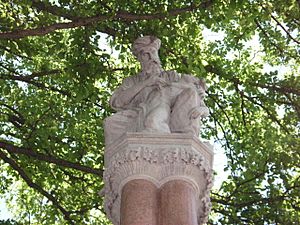Ether Monument facts for kids

"Ether Monument" in the Public Garden.
|
|
| Coordinates | 42°21′17″N 71°04′17″W / 42.3548°N 71.07140°W |
|---|---|
| Location | Public Garden, Boston, United States |
| Designer | William Robert Ware and John Quincy Adams Ward |
| Type | Monument |
| Height | 40 feet |
| Completion date | 1868 |
| Dedicated to | Use of diethyl ether in anesthesia |
The Ether Monument, also known as The Good Samaritan, is a special statue and fountain. You can find it in Boston's beautiful Public Garden. It is near the corner of Arlington Street and Marlborough Street.
This monument celebrates the discovery of using a medicine called ether to make people feel no pain during surgery. This is called anesthesia. The monument was designed by William Robert Ware and John Quincy Adams Ward. It stands 40 feet (about 12 meters) tall. It is the oldest monument in the Public Garden.
Contents
What Does the Ether Monument Look Like?
The statue shows a doctor from long ago, wearing a robe and a turban. He looks like a Good Samaritan, a kind person who helps others. The doctor is holding a man who looks weak and almost naked on his knee.
In his right hand, the doctor holds a cloth. This cloth suggests the use of ether, a medicine that would be discovered much later. The monument shows a doctor from the past using a future discovery. This was probably done on purpose. It helped avoid arguments about who first discovered ether for anesthesia. Many people, like William T. G. Morton and Crawford Long, claimed they were the first.
Messages on the Monument
At the bottom of the statue, there are important messages. These messages explain why the discovery of ether was so important. They also include quotes from the Bible.
- One message says: "To commemorate the discovery that the inhaling of ether causes insensibility to pain. First proved to the world at the Mass. General Hospital in Boston, October A.D. MDCCCXLVI." This means it celebrates the first time ether was used to stop pain, which happened in Boston in 1846.
- Another message quotes from the Book of Isaiah: "This also cometh forth from the Lord of Hosts which is wonderful and excellent in working." This suggests the discovery was a wonderful gift.
- A third message explains: "In gratitude for the relief of human suffering by the inhaling of ether a citizen of Boston has erected this monument A.D. MDCCCLXVII." This tells us a Boston citizen paid for the monument in 1867 to thank ether for helping people.
- The last message is from the Book of Revelation: "Neither shall there be any more pain." This expresses hope for a future without suffering.
History of the Monument
The first successful use of ether for surgery happened at Massachusetts General Hospital. This hospital is only about a 15-minute walk from where the monument stands. The operating room where this important event took place is now called the Ether Dome. It is a special historical place.
The Ether Monument was built in 1868. It was cleaned up and rededicated in 2006.
Keeping the Monument Beautiful
The monument is outdoors in a place with tough weather. This means it needs regular care and repairs. One way people help pay for its upkeep is by donating money. These donations go to a fund that helps preserve the monument for many years to come.
Images for kids







